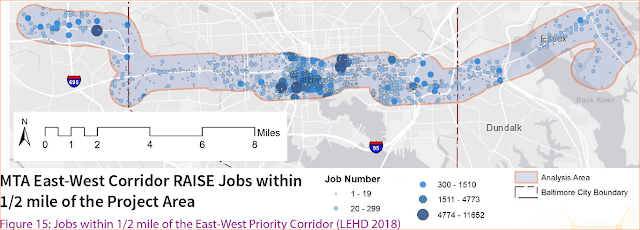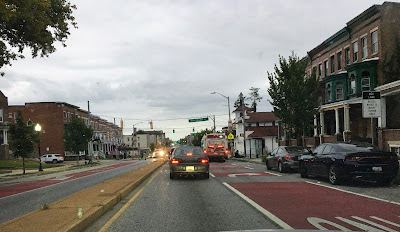 |
| Will this RAISE project deliver all the big promises? DOT Secretary Buttigieg, MDOT Secretary Slater and MTA Administrator Arnold at the grant announcement (Photo: SUN) |
The reality is more modest. The federal grant is for $22 million under the Rebuilding American Infrastructure with Sustainability and Equity (RAISE) program. The federal money will be matched by an $18 million investment from the Maryland Department of Transportation (MDOT) and $10 million from the Baltimore City Department of Transportation. (BCDOT). The award is for the infamous east-west corridor that emerged many times in Baltimore's history as a Baltimore transportation promise or failure.
- When it was designed as a super highway that (luckily) never became reality and ended with a whimper at the I-70 park and ride lot instead
- when a short realized portion of the freeway, the "highway to nowhere destroyed thousands of homes and displaced their African American residents
- when a western metro extension, designed to go along the highway, never materialized
- when Governor Hogan killed the Red Line
- when Obama's DOT Secretary Foxx came to Baltimore to denounce the inequitable impacts of urban freeways such as the Highway to Nowhere and promised funds for a fix
- when a new Regional Transit Plan prepared under Hogan once again confirmed the corridor as a high priority for transit.
The Highway to Nowhere is part of the selected east west corridor
(Photo: From MDOT application)
The measures suggested for RAISE the east-west corridor project are very similar:
- At least 10 lane miles of dedicated bus lanes
- Transit signal priority implementation along Edmondson Avenue, Fayette Street and Eastern Avenue
- ADA access improvements
- real-time signage, bus shelters, benches, trash cans and bio-retention facilities at over 100 bus stops
- Enhancements to pedestrian and bike safety, including crosswalks, curb extensions, ADA curb ramps, signal upgrades at select intersections and a 1.5-mile on-street protected bicycle lane
 |
| Red Line Station Allendale (Rendering: AECOM) |
In spite of its small size, the RAISE project claims to address many major deficiencies in the corridor, namely transit equity.
Delivering on all of those counts within the given budget will be a tall order. Tinkering with the bus operations via better timed signals and dedicated bus lanes and better stops can accelerate the bus speeds, make the service probably a bit more reliable (especially given that over 1/3 of all buses in this corridor are not on time today) and make the wait at the stops more comfortable. But the improvements will do little to provide equity or draw new riders. Based on what one can see in the North Avenue corridor, RAISE will hardly be a qualitative leap, especially if the improvements are spread over 5 years as planned.
The good news is that the MTA wrote an excellent grant application that promptly led to the approval of the full requested amount and brought the Secretary here to tout the project as a model for the national RAISE program. Another piece of goods news is that the City has upped their financial involvement significantly and is now a much stronger partner for MTA than in the North Avenue Rising project. such partnership is a precondition for better transit: The jurisdiction that manages the streets, the signals,the approaches to the stops and the land use in the corridor must do its part so that the transit service is embedded in good management of the land on which it happens and which it serves. The increased collaboration between City DOT and MTA is, therefore a good start.
This Project will address several key transportation challenges in the Baltimore region, identified through community engagement, a regional transportation planning process, Baltimore City DOT’s Transportation Equity Gap Analysis Technical Report, and a Johns Hopkins University transportation equity study. These challenges include:
- Need for an efficient, reliable route from east to west in Baltimore,
- Travel delays for riders of the region’s most heavily traveled bus routes
- Underserved communities in east and west Baltimore need greater transit reliability
- ADA non-compliance at bus stops
- Vehicle-centric roadway design
 |
| Corridor employent (From the MDOT grant application) |
Delivering on all of those counts within the given budget will be a tall order. Tinkering with the bus operations via better timed signals and dedicated bus lanes and better stops can accelerate the bus speeds, make the service probably a bit more reliable (especially given that over 1/3 of all buses in this corridor are not on time today) and make the wait at the stops more comfortable. But the improvements will do little to provide equity or draw new riders. Based on what one can see in the North Avenue corridor, RAISE will hardly be a qualitative leap, especially if the improvements are spread over 5 years as planned.
The expansion of dedicated bus lanes on the corridor is expected to generate up to 1,050 hours of travel time savings for transit riders per day and 262,387 hours per year.(from the grant application)
 |
| North Avenue Rising: Designated bus lanes (Photo: Philipsen) |
Other urgently needed elements that would make the modest investments of RAISE more of a down payment and an initial investment rather than an end in itself are not yet in place. They include
- A clear vision of how transit would function in the corridor in 5 or 10 years. If the ultimate goal is light-rail like the Red Line running in the median, even initial designated bus lanes should also run in the median.
- If the idea is bus rapid transit (BRT) or only a somewhat enhanced "Quickbus" (which once ran in this corridor already), the curb lanes are probably ok as bus lanes. But those more rapid buses would need to be able to pass local buses and this would require special solutions that need to be baked into the original investment right away.
Bus stop enhancements (North Ave Rising) - The corridor has to be seen in light of the complete streets policy in effect in Baltimore City which requires a comprehensive view of streets as public spaces that serve a multitude of functions, some of which compete of surface space, for example resident on street parking, bike lanes, wider sidewalks, street trees, and bus lanes. All this comes into play on Edmondson Avenue which is part of the corridor. North Avenue is still far from the complete street ideal.
- Also needed is a consideration of land use, i.e. of what happens in the corridor left and right of the street. The denser and the better the use along the corridor, the more viable will be the transit. Other agencies and the communities need to get involved and develop a concept of the corridor or its segments that meets their aspirations.
 |
| Project schedule (From MDOT application) |
We’d like to at some point but it will depend on available resources.
Our focus right now is bus operator recruitment and retention to ensure we can deliver scheduled service. (Holly Arnold)
North Avenue needs to provide lessons that will be applied to the new corridor:
- While North Avenue looks a lot nicer after the improvements were made, and while the bus-riders have a somewhat quicker ride (no comparative data about acceleration have been provided), the completed project shows that it isn't sufficient to just put the same transit service on those new bus lanes.
- Per the latest performance report, almost 30% of all buses are still either more than 2 minutes early or more than 7 minutes late (and that is not counting the no-shows). The safety improvements are also voided if the nice red bus lane is used by rogue drivers as the fast lane to zip by everyone else with impunity. This behavior is especially rampant where not enough buses populate the reserved lane to make it plausible.
- An extra tree, a nicer shelter or a safer crosswalk are of no help, if the bus shows late, is already full, doesn't show up at all, because there aren't enough drivers, or there is too long a wait between buses, all still common conditions on the Gold Line which is far from achieving a Gold Standard.
As for land use in the RAISE corridor: For the Red Line 18 community groups worked around visions for the areas where Red Line stations had been planned. Those consensus ideas are still there and there is no reason why they shouldn't be utilized even for an enhanced bus service. There is no point to run accelerated buses through communities where vacant buildings line the route. Transit improvement and economic development need to go hand in hand. Only then will the full throated words of equity and opportunity get meaning. No such plans currently exist. When I asked BCDOT Director Sharkey recently whether such a more comprehensive approach involving additional city departments was intended, he seemed to consider this as an interesting idea, but it is apparently not currently planned, even though the grant application application certainly mentions land use.
 |
| Modeled time savings from bus lanes and signal priority (from the MDOT application) |
Baltimore City agencies are already working collaboratively to coordinate transit investments and land use decisions as MDOT MTA implements the Central Maryland Regional Transit Plan’s long-term Regional Transit Corridor studies as well as near-term investments in the Transit Priority Initiative. (Application)
The grant application claims monetary benefits of $77.7 million over a 20 year operation time of the project. The savings include travel time savings, savings from lower bus operation cost, lower bus breakdown, emissions savings and attraction of additional riders. If these savings would actually accrue in nearly the predicted terms, the investment of $50 million surely seems worth it. A more revitalization oriented comprehensive approach with an ambitious longer term transit strategy would add substantial additional value. That ball is now in the City's court.
Klaus Philipsen, FAIA


No comments:
Post a Comment